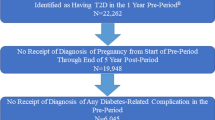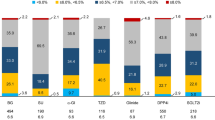Abstract
Aims
To assess the relationship between regularity of follow-up and risk of complications in patients with type 2 diabetes (T2DM) followed up for 9 years at a tertiary diabetes center in India.
Methods
We compared glycemic burden [cumulative time spent above a HbA1c of 53 mmol/mol (7 %)] and incidence of diabetes complications (retinopathy, neuropathy, nephropathy, peripheral arterial disease, coronary heart disease) between 1,783 T2DM patients with “regular follow-up” (minimum of three visits and two HbA1c tests every year from 2003 to 2012), and 1,798 patients with “irregular follow-up” (two visits or less and one HbA1c or less per year during the same time period), retrospectively identified from medical records. Cox proportional hazards models were used to estimate risk associated with diabetes complications.
Results
Compared to those with regular follow-up, the irregular follow-up group had significantly higher mean fasting and postprandial plasma glucose, HbA1c, glycemic burden, total and LDL cholesterol, and triglycerides at every time point during the 9 years of follow-up. Those with irregular follow-up had double the total and mean monthly glycemic burden and 1.98 times higher risk of retinopathy (95 % CI 1.62, 2.42) and 2.11 times higher risk of nephropathy (95 % CI 1.73, 2.58) compared to those with regular follow-up, even after adjusting for time-varying confounding variables. Complications tended to develop significantly earlier and were more severe in those with irregular follow-up.
Conclusion
Among patients with type 2 diabetes, regular follow-up was associated with significantly lower glycemic burden and lower incidence of retinopathy and nephropathy over a 9-year period.

Similar content being viewed by others
References
The Diabetes Control and Complications Trial Research Group (1993) The effect of intensive treatment of diabetes on the development and progression of long-term complications in insulin-dependent diabetes mellitus. N Engl J Med 329:977–986
UK Prospective Diabetes Study (UKPDS) Group (1998) Intensive blood glucose control with sulphonylureas or insulin compared with conventional treatment and risk of complications in patients with type 2 diabetes (UKPDS 33). Lancet 352:837–853
Mudaliar U, Kim WC, Kirk K, Rouse C, Narayan KM, Ali M (2013) Are recommended standards for diabetes care met in Central and South America? A systematic review. Diabetes Res Clin Pract 100:306–329
AliMK Bullard KM, Saaddine JB, Cowie CC, Imperatore G, Gregg EW (2013) Achievement of goals in US diabetes care 1999–2010. N Engl J Med 369:587
Stone MA, Charpentier G, Doggen K, Kuss O, Lindblad U, Kellner C, Nolan J, Pazderska A, Rutten G, Trento M, Khunti K, GUIDANCE Study Group (2013) Quality of care of people with type 2 diabetes in eight European countries: findings from the Guideline Adherence to Enhance Care (GUIDANCE) study. Diabetes Care 36:2628–2638
Unnikrishnan R, Anjana RM, Deepa M, Pradeepa R, Joshi SR, Bhansali A, Dhandania VK, Joshi PP, Madhu SV, Rao PV, Lakshmy R, Jayashri R, Velmurugan K, Nirmal E, Subashini R, Vijayachandrika V, Kaur T, Shukla DK, Das AK, Mohan V (2014) Glycemic control among individuals with self-reported diabetes in India—the ICMR–INDIAB study. Diabetes Technol Ther 16(9):596–603
Kahn SE, Haffner SM, Heise MA, Herman WH, Holman RR, Jones NP, Kravitz BG, Lachin JM, O’Neill MC, Zinman B, Viberti G, ADOPT Study Group (2006) Glycemic durability of rosiglitazone, metformin, or glyburide monotherapy. N Engl J Med 355(23):2427–2443
American Diabetes Association (2014) Standards of medical care in diabetes. Diabetes Care 37(Suppl. 1):s14–s80
International Diabetes Federation. Global guideline for type 2 diabetes. Accessed at www.idf.org/sites/default/files/IDF%20T2DM%20Guideline.pdf on 09.08.2014
Alberti KGMM, Zimmet PZ (1998) Definition, diagnosis and classification of diabetes mellitus and its complications. Part 1: diagnosis and classification of diabetes mellitus. Provisional report of a WHO consultation. Diabet Med 15:539–553
Mohan V, Shanthi Rani CS, Amutha A, Dhulipala S, Anjana RM, Parathasarathy B, Unnikrishnan R (2013) Clinical profile of long-term survivors and nonsurvivors with type 2 diabetes. Diabetes Care 36(8):2190–2197
Friedewald WT, Levy RI, Fredrickson DS (1972) Estimation of the concentration of low-density lipoprotein cholesterol in plasma, without use of the preparative ultracentrifuge. Clin Chem 18:499–502
Brown JB, Nichols GA, Perry A (2004) The burden of treatment failure in type 2 diabetes. Diabetes Care 27:1535–1540
Nichols GA, Rosales AG, Perrin NA, Fortmann SP (2014) The association between different A1c-based measures of glycemia and risk of cardiovascular disease hospitalization. Diabetes Care 37:167–172
Early Treatment Diabetic Retinopathy Study Research Group (1991) Grading diabetic retinopathy from stereoscopic color fundus photographs: an extension of the modified airlie house classification. ETDRS Report No.10. Ophthalmology 98:786–806
Rema M, Premkumar S, Anitha B, Deepa R, Pradeepa R, Mohan V (2005) Prevalence of diabetic retinopathy in urban India: the Chennai Urban Rural Epidemiology Study (CURES) Eye Study 1. Invest Ophthalmol Vis Sci 46:2328–2333
Unnikrishnan RI, Rema M, Pradeepa R, Deepa M, Shanthirani CS, Deepa R, Mohan V (2007) Prevalence and risk factors of diabetic nephropathy in an urban South Indian population: the Chennai Urban Rural Epidemiology Study (CURES 45). Diabetes Care 30(8):2019–2024
Pradeepa R, Rema M, Vignesh J, Deepa M, Deepa R, Mohan V (2008) Prevalence and risk factors for diabetic neuropathy in an urban south Indian population: the Chennai Urban Rural Epidemiology Study (CURES-55). Diabet Med 25:407–412
Premalatha G, Shanthirani S, Deepa R, Markovitz J, Mohan V (2000) Prevalence and risk factors of peripheral vascular disease in a selected South Indian population. The Chennai Urban Population Study (CUPS). Diabetes Care 23:1295–1300
Mohan V, Deepa R, Rani SS, Premalatha G (2001) Prevalence of coronary artery disease and its relationship to lipids in a selected population in South India: the Chennai Urban Population Study (CUPS No. 5). J Am Coll Cardiol 38:682–687
Cho NH, Kim TH, Woo SJ, Park KH, Lim S, Cho YM, Park KS, Jang HC, Choi SH (2013) Optimal HbA1c cutoff for detecting diabetic retinopathy. Acta Diabetol 50:837–842
Khunti K, Wolden ML, Thorsted BL, Andersen M, Davies MJ (2013) Clinical inertia in people with type 2 diabetes: a retrospective cohort study of more than 80,000 people. Diabetes Care 36:3411–3417
Nathan DM; DCCT/EDIC Research Group (2014) The diabetes control and complications trial/epidemiology of diabetes interventions and complications study at 30 years: overview. Diabetes Care 37:9–16
Holman RR, Paul SK, Bethel MA, Matthews DR, Neil HA (2008) 10-year follow-up of intensive glucose control in type 2 diabetes. N Engl J Med 359:1577–1589
SolimanAM Carlson AM, MacLehose RF, Brummel AR, Schommer JC (2013) Patient characteristics predicting the frequency of medication therapy management visits for patients with diabetes. Clin Ther 35:534–540
Morrison F, Shubina M, Turchin A (2011) Encounter frequency and serum glucose level, blood pressure, and cholesterol level control in patients with diabetes mellitus. Arch Intern Med 171:1542–1550
Kumpatla S, Kothandan H, Tharkar S, Viswanathan V (2013) The costs of treating long-term diabetic complications in a developing country: a study from India. J Assoc Physicians India 61:102–109
Bandello F, Lattanzio R, Zucchiatti I, Del Turco C (2013) Patho physiology and treatment of diabetic retinopathy. Acta Diabetol 50:1–20
Pradeepa R, Prabu AV, Jebarani S, Subhashini S, Mohan V (2011) Use of a large diabetes electronic medical record system in India: clinical and research applications. J Diabetes Sci Technol 5:543–552
Kern LM, Edwards A, Kaushal R (2014) The patient-centered medical home, electronic health records, and quality of care. Ann Intern Med 3(160):741–749
Herrin J1, da Graca B, Aponte P, Stanek HG, Cowling T, Fullerton C, Hollander P, Ballard DJ (2014) Impact of an EHR-based diabetes management form on quality and outcomes of diabetes care in primary care practices. Am J Med Qual. doi:10.1177/1062860613516991
Eggleston EM, Klompas M (2014) Rational use of electronic health records for diabetes population management. Curr Diab Rep 14:479
Acknowledgments
We thank the staff of Dr.Mohan’s Diabetes Specialities Centre and Madras Diabetes Research Foundation, Chennai for their help with this study. We also thank Ms. S. Jebarani, Senior Manager – Software, Dr. Mohan’s Diabetes Specialities Centre for retrieving the data and Dr. P. Venkatesan, Assistant Director & Head, Department of Statistics, Tuberculosis Research Centre, Chennai for helping with the analysis.
Conflict of interest
Ranjit Mohan Anjana, Coimbatore Subramanian Shanthirani, Ranjit Unnikrishnan, Poongkunran Mugilan, Anandakumar Amutha, Haridas Divya Nair, Sivasankaran Subhashini, Ulagamathesan Venkatesan, Mohammed K Ali, Harish Ranjani, Viswanathan Mohan declare that they have no conflict of interest.
Ethical standard
This study was approved by the Institutional Ethics Committee of the Madras Diabetes Research Foundation, Chennai, India.
Human and animal rights disclosure
All procedures followed were in accordance with the ethical standards of the responsible committee on human experimentation and with the Helsinki Declaration of 1975, as revised in 2008.
Informed consent disclosure
Informed consent was obtained from all patients for being included in the study.
Author information
Authors and Affiliations
Corresponding author
Additional information
Managed by Massimo Federici.
Electronic supplementary material
Below is the link to the electronic supplementary material.
Rights and permissions
About this article
Cite this article
Anjana, R.M., Shanthirani, C.S., Unnikrishnan, R. et al. Regularity of follow-up, glycemic burden, and risk of microvascular complications in patients with type 2 diabetes: a 9-year follow-up study. Acta Diabetol 52, 601–609 (2015). https://doi.org/10.1007/s00592-014-0701-0
Received:
Accepted:
Published:
Issue Date:
DOI: https://doi.org/10.1007/s00592-014-0701-0




